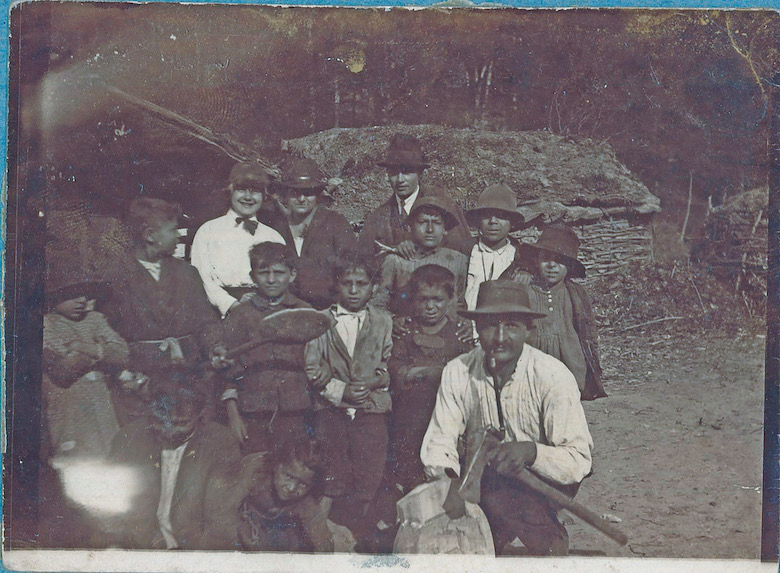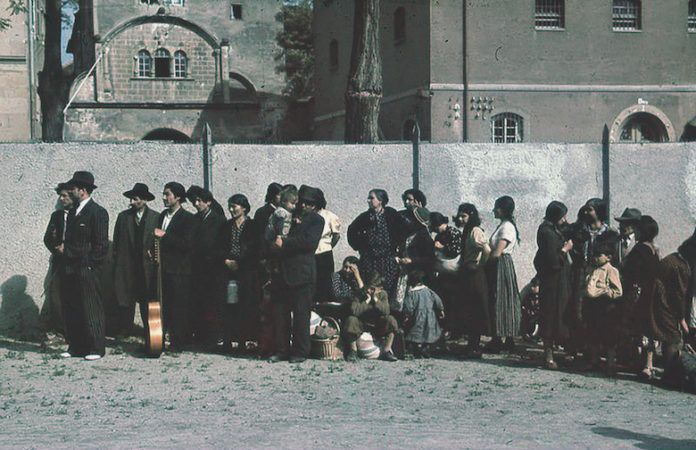The Roma began to emigrate from their ancestral homeland India in the 5th century, and in the 9th , their first contact with the European population was recorded. They came to the area of Southeast Europe – thus also to the area of today’s Croatia – in the 14th century, and the distrust and caution with which the natives looked at them at that time persisted during subsequent centuries. They were distinguished by their darker skin color, and because of their customs, they were considered to be pagans and a savage people that lacks manners. Local workers and serfs were convinced that the Roma were endangering them with their craft skills and work, while the rulers could not force them to adapt to the existing social order. For example, it was difficult to register them in the registry and tax books due to the lack of permanent residence. For this reason, for the purpose of control, numerous anti-Roma laws were passed restricting their movement, banning them from traveling and forcing them to settle, forbidding them to use their own language and to dress in an “exotic” manner that deviates from the majority population’s clothing.
In the 15th century, towards the end of the Middle Ages, humanism emerged as a cultural movement whose goal was to revive the spirit of antiquity. The worldview is changing, so man as an individual is moving to the center of interest, and the teaching that all social relations must be based on respect and tolerance of human nature, with the aim of the unity of the human race, is spreading. However, the selective approach of this period soon came to the fore, as the humanistic worldview applied only to Catholics and Caucasians. They were therefore considered superior to members of other cultures, including the Roma, and this is exactly what János Bársony, a Hungarian ethnologist and researcher specializing in minority issues, argues in his book Pharrajimos – The Fate of the Roma in the Holocaust:
The world of restrictive humanism thought has, by relying on ‘cultural supremacy’ and ‘fighting barbarism and atheism’ – by believing in the primitiveness, backwardness, uncivilizedness of enslaved people ‘incapable of developing’, treating them as ‘criminal hordes’, ‘exotic, and above all dangerous savages’ – managed to convince itself of the ‘correctness’ of an awareness of one’s own superiority, thus justifying the legitimacy of one’s right to kill, rob, and repress.
This is the kind of environment in which the Roma lived from the end of the 15th to the 19th century. In the Romanian principalities of Wallachia and Moldavia they were enslaved, in Germany, Saxony and Prussia, they were banned from trading. Men were sent to forced labor, women were punished by whips and stamping, and children were separated from their parents. Shooting them was permitted without any consequences if they resisted arrest. The absurdity went so far that “Gypsy hunts” were organized in cities purely for the purposes of entertainment the population, and for everyone caught – dead or alive – a prize was given. After numerous anti-Roma laws, the peak in France was reached during the autarchy of Louis XIV. who ordered the arrest of all Roma men and their forcible removal to galleys as slaves, while women were to be made infertile and children to be sent to orphanages.
For more than 300 years, persecution and expulsions have been the predominant methods in the authorities’ fight against the Roma throughout Europe, for example in Portugal, Spain, Great Britain and other countries. But once faced with unsuccessful attempts to expel the Roma from their territories forever, from the second half of the 19th century onwards, rulers began looking for new methods of solving the “Gypsy problem”, one of which was assimilation based on the ruler’s decree. In order to force the Roma to a sedentary lifestyle, the ruler of the Habsburg Monarchy, Maria Theresa, allotted them land and confiscated horses and carts, and her successor, Joseph II, continued this practice. The Roma were forbidden to use the Romani language and were not allowed to marry each other. Their children were forcibly taken away and placed in Hungarian agricultural families.
Such traumatic scenes of child abductions were vividly described by the French writer Claudia Mayerhofer in her travel book Rural Gypsies: The Culture and History of Burgenland Roma from the First Republic to the Present, published in 1987:
On that day, terrible for the people concerned and still haunting them, soldiers appeared in a car and took the Gypsies’ children, from newborns to newlyweds who were still wearing wedding suits. The despair of these poor people is indescribable. Parents threw themselves on the ground in front of the soldiers and climbed on the cars that were taking their children. They pushed them away with rifle sticks and rifle butts, and as they could not follow the carts that took away what they loved most – their small children –many parents immediately committed suicide. The gypsies could not be convinced of the great morality they were preached, nor of the purpose of their victimhood.
An attempt of assimilation was also carried out in Spain and Germany, but even these cruel methods failed to destroy Romani culture or traditional way of life. Throughout Europe, the complete assimilation of the Roma with the rural population occurred only in eastern Hungary and in Burgenland in Austria.

The position of the Roma in Europe was not particularly favorable even in the middle of the 20th century because industrialization, which contributed to the disappearance of colonial empires, devalued the products of their traditional crafts. Large Romani communities began to disintegrate, few adopted a civic way of life, more became labor for hire, and the remaining communities were pushed to the social periphery and left to scrape. Also, police persecutions became more frequent and hereditary criminal tendencies of the Roma were talked about more and more often. Thus, 15,000 to 16,000 Roma, which is how many of them lived on the territory of Croatia in the 1930s, were again turned into a burning problem that the authorities must solve.
The ever-present hostility towards Roma neighbors in later centuries was further emphasized by media propaganda, and Danijel Vojak, a graduate historian and professor of history and senior research assistant at the Institute of Social Sciences “Ivo Pilar”, spoke about the influence of the media on the social scene of the Independent State of Croatia before, during and after the Second World War in his lecture held online on November 11th this year, organized by the Center for Tolerance in Zagreb. Referring to the original newspaper articles, Vojak concluded that the media were the main means of spreading the negative image of the Roma people, with the aim of not questioning the correctness and necessity of subsequent persecutions, deportations and liquidations. Such a practice was also present in the rest of Europe. The article titled What We Will Finally Do with Gypsies, for example, states that “these Gypsies spread the contagion of dishonesty and evil among the people”, while another article highlights the danger they pose to other citizens:… “Gypsies should be removed from Croatian villages in which they pry out – either by grace or by force – the Croatian farmer’s heavy torment. Needless to say, the Croatian countryside was never safe from these eternal travelers”… Then, even propaganda films were made, depicting the supposed educational purpose of the Roma staying in camps like Jasenovac, and that was to teach them to work and “live properly”.
Although positive examples of unity between members of the Roma and non-Roma population in that period were in the minority, Vojak made a special effort to highlight them. He mentioned a group of residents from Koprivnica who sent letters to the authorities asking to release certain Roma from the Danica concentration camp, and residents of Kutjevo who tried unsuccessfully to save the imprisoned Roma by sending a petition to the central Ustasha authorities, as did a group of peasants from Gunja. Another shining example is Jakov Prijavec, commander of the Sokolovac Gendarmerie Station in the Koprivnica district, who in July 1941 refused to carry out an order to deport the Roma.
Eminent experts, including Donald Kennrick, Grattan Puxon, Ian Hancock and Sir Angus Fraser, who have been involved in the reconstruction of Romani history throughout their lives, have proved that this was precisely extermination on the basis of racial affiliation. Speaking of respected experts, we should certainly point out some of our scientists – the aforementioned Danijel Vojak, as well as Alen Tahiri, director of the Office for Human Rights and the Rights of National Minorities of the Republic of Croatia, who, among other things, contributed to the quality of the project titled Romani Suffering on the territory of the Independent State of Croatia during World War II, which was carried out by the Ivo Pilar Institute of Social Sciences. The period following World War II is called the “Forgotten Holocaust” for the Roma because the genocide against the Roma was never officially accepted. Until the 1960s, courts in Germany rejected the recognized Nazi genocide of Romani people, claiming that they were imprisoned and punished for their crimes, not as victims of racial laws. However, 1982 witnessed a formal recognition.
Constructing a Romani identity has always been considerably more difficult. Personal and family memories have yet to become part of the collective memory of the Roma as a national group, so that they themselves can present the historical processes they went through as a people. The words of Dr. sc. Ljatif Demir, a professor at the Department of Indology and Far Eastern Studies at the Faculty of Philosophy in Zagreb, best summarize the historical background that defined the position of the Roma in society:
The Roma have always been a subject that history has played with in a drastic way. They are perhaps the only people in the world who have not written their own history. The Roma unconsciously carry with them a feeling from their ancient homeland of India that says it is a great sin to bear the burden of the past, and that history should be forgotten in order to move more easily through life. Others have written about the Roma. Information on the history of the Roma is most often found in city or prison archives, laws prohibiting them residence in Europe, and these laws provided for persecutions, executions or mass exterminations. The Romani way of life described by Gadže (non-Roma) is most often generalized and defined for centuries through the description of excesses caused by Romani individuals, their exotic way of dressing, child pickpocketing and theft, and no Romani group is spared from this generalized prejudice. And they described their lives just as the most famous writers in the world described it: ‘For us, the harshness of the sky is a light breeze, snow is refreshment, rain is swimming, thunder is music, and lightning is torch, hard earth is a soft feather for us…in the dungeon we sing, while we are tormented we are silent… we have what we want, because we are satisfied with what we have…’












